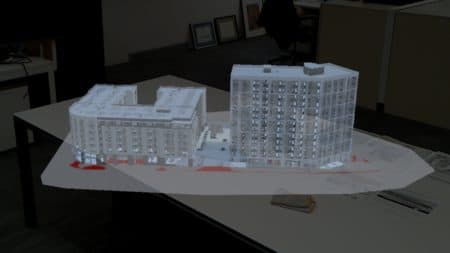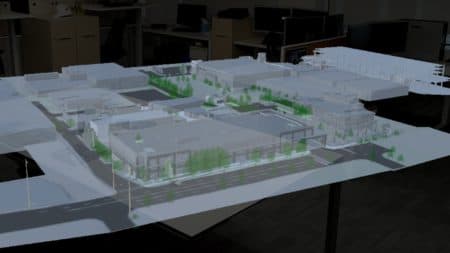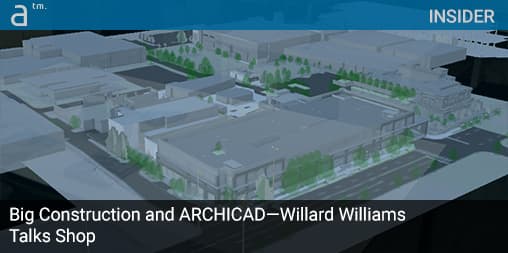GRAPHISOFT IS A COMPANY that is very aware of the impact and potential of the rising next generation of AEC professionals. So much so that they revised their user-interface in version 20 around the notion of making it reflect not just BIMx, its mobile app, but trends in mobile user-interface design in general. In this particular feature Architosh talks to a new leader in this next generation of professionals, Willard Williams.
Williams works for Hoffman Construction Company, in a specialized role befitting of a licensed architect and technology-forward AEC professional. His official title is VDC Coordinator.
I caught up with Williams at the 2017 GRAPHISOFT North American User Conference—where he presented in a session on VR—and we sat down to discuss his unique perspective on BIM and his diversified experiences leading him to where he is now.
The Interview
Your experiences are quite diverse and different, and you have worked for several of the country’s best ARCHICAD firms, did you learn ARCHICAD in architecture school and what school did you attend?
I graduated from Cal State Pomona (California Polytechnic University Pomona.) I was introduced to ARCHICAD while interning for an architecture firm. I also used it school and Evan Troxel was one of the professors who taught ARCHICAD while I was there, though I was already using it heavily by the time I took his course.
I was training firms and individuals throughout southern California under Digital Vision, and John Stebbins while I was attending Cal Poly.
Were there many students there using ARCHICAD?
I was just one of a few students at Cal Poly at the time using it though Evan Troxel taught it at the school. A lot of students at that point were using SketchUp, or 3ds Max, or Maya. I felt like you couldn’t get the same level of documentation out of those tools as easily as ARCHICAD.

01 – Willard has deep experience taking ARCHICAD BIM models into Unreal Engine from which he can take them to deeper virtual reality (VR) experiences like in this example here.
Additionally, it helped me make production-ready physical models because it was easy for me to get the model ready for a laser cutter and I could see my schoolmates struggling with that aspect immensely with the tools they were using. Today it is obviously different with access to 3D printers and other tools.
You went to work for Orcutt | Winslow and then Walker Warner, what were those experiences like and how did they advance your know-how with ARCHICAD?
I started at Orcutt Winslow just before the great recession. They were over 110 people then, and I believe the largest ARCHICAD firm in North America. There I got a taste to do more mission-critical buildings while at Orcutt and I came in at pretty high level; from day one I was running out of the gate and was quickly promoted to BIM leader for the healthcare studio.

02 – Willard Williams, architect, presenting at BIMCON 2017 on ARCHICAD and the Unreal Engine as a pathway to advanced VR in architecture and construction.
OWP was great to see how large firms, with large teams, and projects could work together, especially with Teamwork. Just before I went to Phoenix for OWP I was designing a house in Brea, California, and working with a colleague in Montana. We had to hack together a method for working on a teamwork file using a VPN with a VPN accelerator. It was very tough but once we got it going we felt like rock stars. At OWP there wasn’t very much actual Teamwork taking place when I got there. So within my first week, I got the IT team to set up a BIMServer and quickly brought the team I was working with on a large campus project into the fold. It was awesome and soon became the company standard for working on projects with multiple members.
One of the things I like about GRAPHISOFT is they make strong relationships with partners, even those who they compete against…
Walker Warner Architects was also a very rewarding experience on many levels. They do stunning work in some awesome locations and the amazing team is very dedicated to the architecture that has made the firm’s name. I was there Digital Design Coordinator and the position allowed me to dive more into a BIM management and R&D position; I was able to explore solutions for teams and projects and look ahead.
Any interesting IT or BIM war stories from those two firms?
Absolutely. One day one at WWA, about two hours after getting there the BIM Server had a serious meltdown and it really tested my abilities. I think I left that night at 7 pm before it was running again. In the end, WWA was very advancing for me because it tested my abilities as an ARCHICAD trainer, project forensics, and triage.
As a younger generation architect, what personally draws you to ARCHICAD?
Well, it’s the interface, some of the tools and how it operates. It is a super quick, very efficient, and highly optimized software. One of the things I like about GRAPHISOFT is they make strong relationships with partners, even those who they compete against as in the case with their excellent plugins for [Autodesk] Revit for interoperability.
One thing that really made an impression on me was when Viktor Varkonyi took over as CEO in 2009. Viktor really took the company in a new direction with the iterative software releases every year and the quality of the product, which improved significantly.

03 – Another BIM model, in this case, displayed in AR (augmented reality) inside a conference meeting room.
So you are saying Viktor’s leadership brought about a major change in product stability and overall quality that wasn’t there prior?
Absolutely. I was fortunate enough to meet him in 2009 in San Francisco when they rolled out Teamwork 2.0 with the new Delta Server technology.
I want to ask you about the new UI from the version 20 update because it’s aimed at the younger generation. What is your take on that new UI?
I think it is really clean, the colors are nice. It’s a lot simpler both in terms of the design and amount of colors they are using so it’s less distracting.
Did it change the way you wanted it to or were you hoping for a more significant change?
No, I think it changed enough where it wasn’t so severe or shocking; it was just enough where it was calming and refreshing. The simplification masks the true power of the software. I’d rather focus on other stuff not the complexity of the interface.

04 – A slightly different view of the AR scene, more noticeably one can see the actual physical room this experience is taking place in.
Your session at the conference was focused on VR, and you have used it, it seems, quite a bit professionally in your work setting in construction. What is your take on VR in the industry and what can it do for BIM programs like ARCHICAD?
I think VR and AR are just a logical progression of the software itself; it allows us to present information in a way that is highly immersive. And that has not been available for the most part in our industry. So, everyone I’ve talked to who have dove into it from the architecture or construction side…they are not going to go back!
You are in the construction world, do you think the construction industry is embracing VR more than the architects, what is your sense of that?
Well, I think both are embracing it about the same. But they are embracing it in different ways. I think the advantage contractors have they are dealing with the owner on their last mile. So what we are trying to figure out is not just can we show you the building [in VR] but can we add value to the owner’s ongoing needs.
I think the advantage contractors have they are dealing with the owner on their last mile.
We look at the solution more from a constructability, safety, quality, and training perspective. Architects are looking at space, volumes, light quality, textures, and general feel of an architectural element.
As an architect myself I would say that architects too could be asking similar types of things about the ongoing needs of the owner. And they could do the same thing.
Yes, but they are just at the point where they are doing the construction administration, and they are, for whatever reasons, not concerned about producing any more three-dimensional information for the client because it’s not in their agreement. But we feel like, if we can provide the owner with an additional beneficial take away then they are going to remember us the next time they have an opportunity for someone and say “these guys are really pushing the envelope.”

05 – One of GRAPHISOFT’s strongest tools with regard to contractors is its BIMx mobile app. The company in Japan said it had plans to push deeper into the hearts of large general contractors and this is a tool with much potential for that endeavor.
That’s interesting. Do you see the contractors doing this because perhaps they are more business-oriented than the architects or it is because they just have more resources to experiment and provide these value-adds to the owner?
No. I think the architects just have a different role. Once they get to CA, they are done with the model.
The architect at the front end wants to show the quality of the project, and the spatial representation of the project to the client so they can get buy-out for it. But for us, we don’t need to do that. By the time we are working through our issues we are not thinking about how to sell the client on the building but rather convincing the client they are getting a good value for the services we are providing them.
Also, ARCHICAD is just so highly optimized—it does a lot of things that Revit stutters on. And it is not as scary as most people think regarding how to work with it.
But I don’t think it’s a resource thing because a lot of the top or larger architecture firms are buying up the equipment, hiring or evolving people within their companies to be solely dedicated to this technology. The contractors are just delivering with different deliverables and responsibilities.
In the end, the value is there for both the architect, engineer, and contractor to explore and leverage this technology.
You are using ARCHICAD in the US construction market. Do you think it should have a larger role in the US construction industry—it has one in the Japanese industry?
Yes. ARCHICAD is a developer’s type of tool that allows you to bring in a lot of different information, from many sources. For instance, PDF, DWG, C4D, SKP and IFC and many others. Or, if you are translating from Revit files you can use the great ARCHICAD plugins for Revit.

06 – Willard makes the case that BIMx as a mobile tool is powerfully ideal for use in the field on the construction side of the industry and helps clients and the non-visual truly understand the building and, importantly, the relationship between drawings and the BIM model.
Also, ARCHICAD is just so highly optimized—it does a lot of things that Revit stutters on. And it is not as scary as most people think regarding how to work with it. I have found that people who know Revit learn ARCHICAD very easily and enjoy it after they have used it for awhile.
You have mentioned or alluded to ARCHICAD’s power over Revit several times. Why is it so powerful in your view?
It’s the optimization that is there. It doesn’t require the hardware resources Revit does. ARCHICAD is just very powerful and on the surface can solve almost any problem. And then if you dig into GDL (Geometric Descriptive Language) scripting you can open up a large portion of its capabilities that are typically hidden.
What kinds of files are you getting from subcontractors and manufacturers?
DWG is popular for the detailers for things like piping layouts. And we get Navisworks files but I’ve been asking them to send IFC files instead, and it is making a huge difference because I can do anything that I was going to do with Revit and Navisworks I can do with IFC and ARCHICAD.
Another reason why ARCHICAD is good for the construction industry is it I can send my clients great BIMx content very easily.
Last question. What do you look forward to or hope for in the future of ARCHICAD?
I don’t know if I am looking for anything more in ARCHICAD after the addition of Rhino and with the integrated Cinema 4D rendering engine. I think the only thing key now is for them to have a super great VR solution—and an AR solution as well.
What I hope for them, to be more competitive, that they become stronger on the MEP and structural side. For example, they have a good MEP tool but to create an MEP drawing that looks like a conventional US-based MEP plan is challenging. In the end, I think ARCHICAD is an amazing tool which is why I have used it and loved using it for nearly 20 years. It will be exciting when BIMx works on the VIVE or Hololens, but as it stands today it is an amazing product.
Editor’s Note: We eliminated a double sentence entry error on 1, Jan 2018. The sentence below image 06 was entered in twice by a bug in WordPress.




Reader Comments
Comments for this story are closed